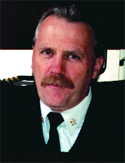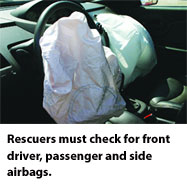
Features
Training
Trainer’s Corner: Airbag awareness is crucial
During a recent visit with my son, a firefighter in Prince George, B.C., and a regular contributor to Canadian Firefighter and EMS Quarterly, we discussed airbag safety restraints. Although neither of us has ever experienced a deployment during an extrication, we are concerned about the possibilities. Aaron and I discussed the need to check auxiliary power ports (cigarette lighter) for anything plugged in, such as a cell phone, laptop or iPod.
December 6, 2007
By Ed Brouwer
 During a recent visit with my son, a firefighter in Prince George, B.C., and a regular contributor to Canadian Firefighter and EMS Quarterly, we discussed airbag safety restraints. Although neither of us has ever experienced a deployment during an extrication, we are concerned about the possibilities. Aaron and I discussed the need to check auxiliary power ports (cigarette lighter) for anything plugged in, such as a cell phone, laptop or iPod. These items may have enough electrical power to “back feed”, causing airbag deployment. In other words, the batteries in these electronic devices may have enough power to reverse flow back into the vehicle electrical system, even though the vehicle battery has been disconnected.
During a recent visit with my son, a firefighter in Prince George, B.C., and a regular contributor to Canadian Firefighter and EMS Quarterly, we discussed airbag safety restraints. Although neither of us has ever experienced a deployment during an extrication, we are concerned about the possibilities. Aaron and I discussed the need to check auxiliary power ports (cigarette lighter) for anything plugged in, such as a cell phone, laptop or iPod. These items may have enough electrical power to “back feed”, causing airbag deployment. In other words, the batteries in these electronic devices may have enough power to reverse flow back into the vehicle electrical system, even though the vehicle battery has been disconnected.
The airbag was invented by Patrick W. Hetrick of Newport, Pa., in 1951 and patented the following year.
A Transport Canada study found that about 8,600 driver and right-front passenger lives were saved by seatbelts over the eight years between 990 and 1997 and that about 152 driver and right- front passenger lives were saved by airbags in the same period.
Still, these safety restraint systems can be detrimental to rescuers if they deploy during an extrication, while the rescuer is between the airbag and the patient. By following proper procedures, the risk of injury to rescue personnel or patients can be greatly reduced.
As much as possible maintain the 5-10-20 rule.
- For side impact curtain/airbags, maintain a safe distance of five inches or more;
- For driver-side frontal airbags, maintain a safe distance of 10 inches or more;
- For passenger-side frontal airbag, maintain a safe distance of 20 inches or more.
 Deployed air bags are not dangerous. However, it should be noted that not all airbags will deploy in a crash. Side-impact airbags are independent of the frontal bags. To decrease the chance of injury to improperly seated infants and children, some smart airbag systems will detect whether there’s a passenger sitting in a seat. A child under 18 or 19 kilograms sitting in the front passenger seat may not arm this type of SRS and therefore the airbag may not deploy in a crash. However, if the electrical supply is not deactivated, a rescuer’s weight could arm the airbag. Sizing up the vehicle is now a more vital part of vehicle extrication. The presence of airbags and automatic rollbars dictate how rescuers will extricate and provide patient care.
Deployed air bags are not dangerous. However, it should be noted that not all airbags will deploy in a crash. Side-impact airbags are independent of the frontal bags. To decrease the chance of injury to improperly seated infants and children, some smart airbag systems will detect whether there’s a passenger sitting in a seat. A child under 18 or 19 kilograms sitting in the front passenger seat may not arm this type of SRS and therefore the airbag may not deploy in a crash. However, if the electrical supply is not deactivated, a rescuer’s weight could arm the airbag. Sizing up the vehicle is now a more vital part of vehicle extrication. The presence of airbags and automatic rollbars dictate how rescuers will extricate and provide patient care.
When sizing up the vehicle, look for icons or symbols depicting airbags or automatic roll bars. Look for words like Supplemental Inflatable Restraint, airbag, or the initials SIR, SRS, SIPS, HPS, IC (Volvo/Mercedes impact curtain) printed on the steering wheel hub, instrument panel, dashboard, windshield, driver’s side B-post/pillar, interior roof rail or on the side or back of the seat when the car is equipped with side airbags. If you are unsure about the vehicle you are working on, check the glove compartment for the owner’s manual. Look inside the vehicle for power plugins (iPod, cell phone, laptop). Disconnect any you find to prevent power feedback. Look for automatic rollbars, dual pop-up or flip-up type. In 1998, Volvo and Mercedes starting using the automatic roll-bar systems in production model convertibles. Mercedes is using both flip-up and dual pop-up roll-bar systems as an option on selected convertibles. These are deceiving in looks and can easily be mistaken for a head rest or as part of the trim to the soft top of the convertible. The roll bars are designed to deploy within three-tenths of a second. Extreme care should be taken in close proximity of any undeployed automatic roll bars. Deployment will take place when the automatic roll-bar sensor detects that wheels are off the ground/surface. The roll-bar system is also connected to the airbag system and may deploy when the airbags are activated.
In some vehicles, the roll-bar system can be manually deployed by the operator, using a dash-mounted switch. If possible, attempt to safely activate the operator’s manual activation switch to manually deploy the system in a controlled sequence. This will prevent injury to patients and rescue personnel from accidental deployment.
Department members should be familiar with new car construction and know how to identify extrication hazards. Knowing the safety benefits of fireground pre-planning, it only makes sense to do extrication pre-planning. It is important to preplan for a MVI, therefore I suggest you consider taking your department or at least your officers to visit a local dealership. Ask about airbags, automatic roll bars, battery locations, security systems, glass construction, vehicle construction and other safety features. Most dealers will be more than happy to show you vehicles and allow you to take pictures. Ask to see the manufacturer’s manual for emergency rescue services. Manufacturers may send your department a copy of their emergency response guidelines for rescues or handouts for your training library upon request.
Until next time, stay safe and remember to train like lives depend on it, because they do!
Points to Remember
- Once an airbag is deployed it will not deploy again;
- Don’t delay medical attention for occupants of a vehicle who have been exposed to chemical residue or smoke;
- Use proper rescue procedures;
- Wear hand and eye protection to prevent minor skin and eye irritation;
- Not all airbags will deploy in a frontal or side collision;
- When in doubt, use the 5-10-20 rule.
Ed Brouwer is the Fire Chief/Training Officer for Canwest Fire and a member of the Osoyoos (B.C.) Fire Dept. The 18-year veteran fire fighter is also a Fire Warden with Ministry of Forests, a First Responder III instructor/evaluator, Local Assistant to the Fire Commissioner and a fire service motivational speaker and chaplain. E-mail ed@thefire.ca .
Print this page
Advertisement
- Flashpoint: Seatbelt issue simmers despite numbers of deaths
- Truck Checks: Air-brake maintenance – part two